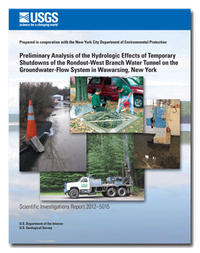Flooding of streets and residential basements, and bacterial contamination of private-supply wells with Escherichia coli (E. coli) are recurring problems in the Rondout Valley near the Town of Wawarsing, Ulster County, New York. Leakage from the Rondout-West Branch (RWB) Water Tunnel and above-normal precipitation have been suspected of causing elevated groundwater levels and basement flooding. The hydrology of a 12-square-mile study area within the Town of Wawarsing was studied during 2008-10. A network of 41 wells (23 unconsolidated-aquifer and 18 bedrock wells) and 2 surface-water sites was used to monitor the hydrologic effects of four RWB Water Tunnel shutdowns. The study area is underlain by a sequence of northeast-trending sedimentary rocks that include limestone, shale, and sandstone. The bedrock contains dissolution features, fractures, and faults. Inflows that ranged from less than 1 to more than 9,000 gallons per minute from the fractured bedrock were documented during construction of the 13.5-foot-diameter RWB Water Tunnel through the sedimentary-rock sequence 710 feet (ft) beneath the study-area valley. Glacial sediments infill the valley above the bedrock sequence and consist of clay, silt, sand, and gravel. The groundwater-flow system in the valley consists of both fractured-rock and unconsolidated aquifers. Water levels in both the bedrock and unconsolidated aquifers respond to variations in seasonal precipitation. During the past 9 years (2002-10), annual precipitation at Central Park, N.Y., has exceeded the 141-year mean.
Potentiometric-surface maps indicate that groundwater in the bedrock flows from the surrounding hills on the east and west sides of the valley toward the center of the valley, and ultimately toward the northeast. On average, water levels in the bedrock aquifer had seasonal differences of 5.3 ft. Analysis of hydrographs of bedrock wells indicates that many of these wells are affected by the RWB Tunnel leakage. Tunnel-leakage influences (water level and temperature changes) in the bedrock aquifer were measured at distances up to 7,000 ft from the RWB Tunnel. Water levels in the bedrock changed as much as 12 ft within 0.5 hour during tunnel shutdowns. Nine of the 10 wells that responded to the shutdowns showed a water-level response of 5 ft or greater. Changes in water levels ranged from 1.5 to 12 ft, with tunnel-leakage influence delay times ranging from 0.5 to 60 hours. Many of the longest tunnel-influence delay times and smallest water-level changes were in wells located closest to the tunnel in shale. Tunnel-influence response of the bedrock aquifer is consistent with its preliminary characterization as an anisotropic aquifer with greater transmissivity along bedding strike than across bedding strike. This tunnel-influence response is also consistent with the likely presence of discrete high-transmissivity networks along fractured limestone beds that have undergone dissolution. A lack of bedrock observation wells in half of the study area hampered a more thorough analysis of the extent of leakage from the RWB Tunnel in the study area.
On average, water levels in the unconsolidated aquifer had a seasonal difference of 5.0 ft. Some unconsolidated-aquifer wells indicated water-level changes due to tunnel leakage. The locations of unconsolidated-aquifer wells with measurable water-level changes due to tunnel leakage correlated with those in the bedrock. Water levels in the unconsolidated aquifer changed as much as 2.5 ft within 18 hours of tunnel shutdowns, but water-level changes in some unconsolidated-aquifer wells were smaller or nonexistent.


